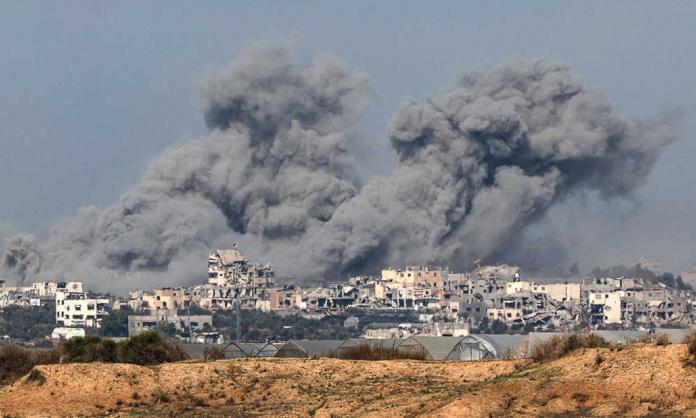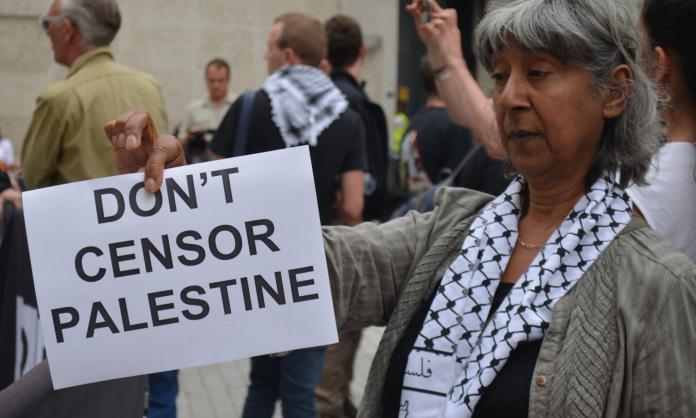On 30 April, Angie Lara woke with a fever. “My first instinct was to call my employer and ask them what I should do”, she says over the phone from Yakima County in Washington State, where she works at Allan Brothers Fruit Company, one of the largest apple-producers in the region. “The company were only interested in how many days I would need off, and when I’d be fit to return to work.”
The local health department wasn’t much help, either. After driving to Mountain View Medical in Yakima, barely able to breath, Angie gets tested, putting her US$152 out of pocket (a day a half’s wages). She’s then told the tests will take a week to process, maybe longer. It’s unclear whether her husband, Jose, who also works at Allan Brothers, will need to self-isolate. The same goes for their two sons, with whom they share a three-bedroom apartment. Both are nurses. After the test, the medical officer hands her a letter that says after three days without symptoms, she’ll be fine to return to work.
Three days later, on 4 May, the phone rings. It’s Angie’s employer. “They ask me if I’m able to return to work.” While Angie has stopped showing many of her symptoms – the fever has passed, and she’s breathing easier – she’s still coughing and feeling fatigued. “I tell them I’m still waiting for my test results and that I want to quarantine. They would have taken me back to work right away if I hadn’t said so.”
On 7 May, the phone rings again. This time it’s one of Angie’s workmates, who tells her to put on a mask and gloves and come down to the warehouse. When Angie arrives, 100 workers have gathered, refusing to return to work. Jose is there, and so too is their close friend and co-worker David, who says he is feeling unwell, and thinks he should go get tested. Most of workers that have gathered are wearing masks and gloves and are attempting to social distance, which is more than can be said about the conditions they’ve walked out from.
“It hasn’t been mandatory to wear a face mask. If you want to protect yourself, you have to provide your own. The machines we are using aren’t being cleaned. Workers have tested positive for the virus, and the company hasn’t informed us. We’ve asked the lines to be shut down until they are safe, but the company won’t listen”, Angie recalls of the speeches. A debate soon begins on what to do next. Half of those gathered return to work – the other half sets up camp.
On 8 May, the second day of the strike, Angie gets another phone call: her test results are positive for COVID-19. Most of her symptoms are now gone, but no one from the health authorities can tell her whether she’s still contagious. On the advice of the strike committee, she stays home for a few days. Over the weekend she gets another call: David has been hospitalised. “By the time I returned to the camp, the number of strikers had been reduced to 35. Some started to feel the pressures: rent and bills to pay, families to feed, fear of retribution from our supervisors. But the group that remained are determined to stay and fight.”
--------------------
Since Yakima County’s first reported case of COVID-19 on 8 March, the region has had the most cases per capita among west coast states. By the end of July, the county had recorded more than 10,000 cases and more than 200 deaths in a population of not much more than 200,000 people. The clusters have been concentrated among health care workers, and in manufacturing, food processing and agriculture, the region’s largest employer. Hispanics and Latinos account for 51 percent of confirmed cases.
Angie, who was born and raised in southern California to Mexican-migrant parents, says she moved to Yakima after her parents relocated. Most of those who work in the region are often migrant and undocumented workers who “follow the fruit picking seasons”.
“Migrant labour has become a growing proportion of the workforce in a number of industries in the US economy”, Justin Akers Chacón, an activist and writer in the San Diego-Tijuana border region, says via email. “Agriculture has historically been the sector most dependent on migrant workers, employing up to 3 million people per year in the US. Most workers are born outside the US, primarily from Mexico but also Central America and the Caribbean. Over half the workforce is undocumented, although many have lived and worked in the US for over at least a decade.”
Many forms of labour control have been used to supress unions, keeping wages depressed, and making work fragmentary, temporary and contingent: contract labour, temporary and seasonal worker-importation programs, and undocumented workers. “In turn, these forms of oppression are backed up by migration enforcement regimes, such as the militarised border walls along the 2,000-mile long US-Mexico border, and the growing ranks of Border Control and Immigration and Customs Enforcement agents that extend into the interior of the country, enabling the maximum exploitation of undocumented labour”, Justin says.
Edgar Franks, political director of Familias Unidas por la Justicia, an independent farmworker union based in the Skagit Valley, four hours’ drive north-west of Yakima, says that Border Patrol and ICE agents have been one of the main barriers for those attempting to organise the sector. “The threat of repression and deportation is always on the minds of undocumented workers”, he says over the phone from Yakima, where he’s currently based as he attempts to aid the strikers. “Because of the racial profiling that goes on, and how aggressive and violent the state is generally, even workers who are citizens live in fear. When we visit the undocumented workers in their homes or in the ‘labour camps’, we need to make sure we don’t attract the wrath of the authorities and get workers deported.”
The “labour camps” in which migrant workers live are ticking time bombs for disease outbreaks. “The camps are usually shanty-towns or former military barracks built during the Second World War”, he says. “The housing is cramped and sometimes company providing housing has over 10 workers in a small shack. They’re not properly insulated. They don’t have proper kitchens. The bathrooms are all communal in which sometimes hundreds of workers share facilities. Transportation to and from work is done through buses. To top it all off, the camps are often right next to fields that are being sprayed with deadly pesticides.” Under these conditions, and with a for-profit health care system that makes it near impossible for most migrant workers to get tested, let alone self-isolate, Edgar says it’s impossible to know how many workers have contracted the virus, nor how many have died as a consequence.
The demographics of those living in the camps has steadily changed during the time Edgar has been working in the sector. Over the course of the 1990s, as the effects of the North American Free Trade Agreement ploughed through Mexico – consolidating the power of capital over labour, and displacing large swathes of peasants from their land – Edgar says more and more workers were coming in from the southern parts of Mexico, as opposed to the north, where his parents had migrated from.
“The Mixteco and Triqui people [from Guerrero and Oaxaca in southern Mexico] are known for their traditions of resistance, which go all the way back to pre-Hispanic times. The Aztecs could not conquer their territories; neither could the Spaniards. To this day, these people still defend their lands against state-led privatisations of essential services [such as education and health care] and further encroachment of capital into these regions. The most militant section of the teachers’ union is based in these parts and has stood up to intense state repression in recent years. These are the places where the workers are coming from – and they bring these traditions with them.”
Between 2013 and 2017, Indigenous workers led a wave of wildcat strikes throughout the Skagit Valley. Concentrated at Sakuma Brothers, the largest supplier for multinational giant Driscolls Berries, the strikes began in response to the sacking and attempted deportation of several migrant workers who had spoken out about living conditions. Since the United Farm Workers Union had long abandoned any pretence of standing up for workers in the sector, the strikes soon blossomed into the right to form a union and bargain collectively over wages and conditions. The strikes were backed up by a three-and-a-half-year boycott campaign against Driscolls. Eventually, the companies caved, signing a historic contract in 2017: the union, Familias Unidas por la Justicia, gained official recognition, a $15 per hour guaranteed wage for all workers, improved housing and health and childcare benefits.
“I heard about all these strikes,” says Angie, “But it didn’t cross my mind that I’d soon be involved in leading one.”
--------------------
The stand taken by workers at Allan Brothers sparked a series of similar walkouts throughout the Yakima Valley throughout May and into early June: fruit packing workers at Mason Fruit, Jack Frost Fruit, Monson Fruit, Columbia Reach, Madden Fruit, and Cold Storage all walked out over similar concerns, raising demands around personal protective equipment, safe working conditions, pay rises and the right to bargain collectively with their employers. Like the walkout at Allan Brothers, the strikes were initiated by the workers, with strike committees soon forming.
Angie says that each of the strike camps are dominated by women leaders who take on many of the leading responsibilities: regular meetings to discuss strategy and tactics, communications with other strikers, negotiating with management and keeping up the morale of strikers through song and prayer.
“The supervisors and bosses would look at us like dirt”, Angie says. “They try to make us feel ashamed of what we were doing.” The camp at Allan Brother is soon threatened by an agitator with far-right sympathies and a known history of violence. But the hostility is also matched with solidarity. Pick-up trucks honk as they pass with clench fists extended from windows. Shouts of support ring out all throughout the day in English, Spanish, Shahaptin and Nimipuutímt (two Indigenous dialects of the north-west region). Activists from the community help provide food, coffee and supplies, coordinating distribution between camps. “I discovered things about myself that I didn’t know I had in me”, Angie says. “Making speeches, trying to convince others in debate, standing up to harassment.”
One of Angie’s roles involved organising early morning prayers for David, who had been in a coma for almost 20 days. The prayers are well attended, not only by strikers, but members of the broader community who visit to and from work. But the prayers aren’t enough to save David from the virus: he dies days before management at Allan Brothers promises to meet the workers’ demands. The strikes at other warehouses continue for several weeks. After 22 days on strike, Angie and the other strikers return to work.
“No one would have known that David had passed away if we didn’t set up a permanent memorial at the shed entrance”, Angie explains. Fundraising efforts to aid David’s family speak volumes: co-workers donate $4,000 (many, like Angie and her family, have lost weeks of wages either on strike, or self-isolating due to the virus); a crowd-fund set up by David’s stepdaughter raises more than $11,000; and Familias Unidas por la Justicia ensure all David’s medical expenses are covered. Allan Brothers gave David’s family a meagre $1,000 and tried to conceal David’s death from other workers. (According to Angie, another worker has since been killed by the virus, but the company has kept the information private.)
After the strikes, much has changed at Allan Brothers. Temperature checks are now conducted upon entry to the premises. Gloves, face masks and protective eye wear are mandatory, as is regular hand sanitisation. Line speeds have been slowed to allow more distance between workers. But the most noticeable changes are among workers themselves. “Many of those [who were] hostile to staying out on strike – and went back in after the first day or so – have now started to come around to the power of being united and organised”, Angie says. “They have seen how we stood up for ourselves and now they won’t accept mistreatment by supervisors. The supervisors don’t yell at us anymore. They are very polite and quick to listen to our concerns.” Many older workers, who have been with the company for two decades or more are now demanding seniority pay for their years of service.
Some things stay the same, however. “Management are constantly trying to find ways to cut corners”, Angie says. “They are rationing our cleaning products so that we have to share them. [Often] this means we are unable to wipe down surfaces properly after use.” Social distancing in the lunchroom is impossible unless a rotating system that keeps numbers down is introduced. The hazard pay that was granted to them after the strike – a meagre $1 bonus per hour – is set to be axed in early August and the wage increases offered for long-term service amount to no more than 25 cents per hour. “The reports coming in from other warehouses is very much the same, or worse”, Angie says.
Since the strike, efforts to establish a recognised union at Allan Brothers, Trabajadores Unidos por la Justicia (Workers United for Justice) have gained momentum. The majority of those on dayshift support its creation, and the group from the strike committee, including Angie, with support from Edgar, have now started agitating among the nightshift workers as well. In response, management has brought in “consultants” to “help facilitate the process”. But Angie and Edgar can smell bullshit from a mile away – “consultants” is management-speak for union busting operations. “We’ve put the company on notice”, Angie says. “What we’ve started will be hard to stop. And we’re not going to stop until we win.”











